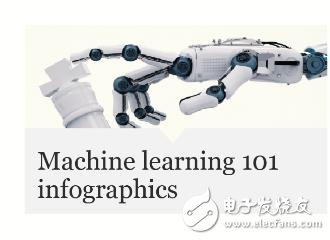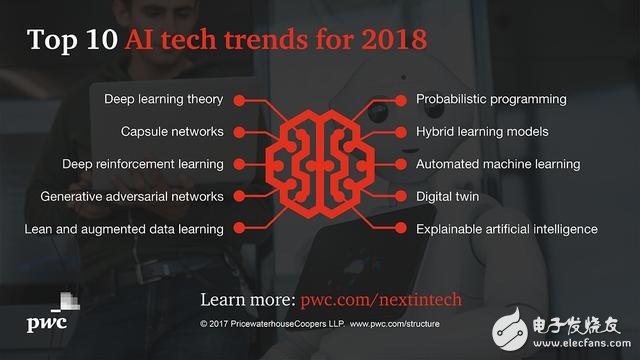Artificial intelligence is at the forefront and center, and business and government leaders are thinking about the right moves. But what happened in the lab? In the laboratory, the discovery of academic and corporate researchers will set the direction for artificial intelligence in the coming year and beyond. Our own research team comes from PricewaterhouseCoopers' AI Accelerator, which focuses on leading development and should be closely watched by both technical and business leaders. This is what they are and why they are important. Here we can also see our top AI trends in business. What it is: Deep neural networks that mimic the human brain have proven their ability to "learn" from image, audio and text data. However, even after more than a decade of use, there are still many deep learning things we don't know, including how neural networks are learned and why they perform so well. This may be changing, thanks to the new theory that applies the principles of information bottlenecks to deep learning. Essentially, it shows that after the initial fitting phase, the deep neural network will "forget" and compress the noisy data - that is, the data set containing a large amount of additional meaningless information - while still retaining the information represented by the data. Why it matters: an accurate understanding of how deep learning enables it to grow and use. For example, it provides insight into optimal network design and architectural choices while providing greater transparency for security-critical or regulatory applications. It is expected that by exploring this theory, more results can be seen and applied to the design of other types of deep neural networks and deep neural networks. What it is: Capsule Network A new type of deep neural network that processes visual information in a similar way to the brain, meaning that they can maintain hierarchical relationships. This is in stark contrast to the convolutional neural network, one of the most widely used neural networks. It does not take into account the important spatial hierarchy between simple objects and complex objects, resulting in high classification errors and high error rates. Why it matters: For typical identification tasks, the capsule network guarantees higher accuracy by reducing the error by 50%. They also don't need much data to train the model. It is expected to see the widespread use of capsule networks in many problem areas and deep neural network architectures. What it is: a neural network that learns through observations, actions, and rewards interacting with the environment. Deep Intensive Learning (DRL) has been used to learn game strategies such as Atari and Go- including the famous AlphaGo program, which defeated the human champion. Why it matters: DRL is the most versatile of all learning technologies, so it can be used in most commercial applications. It requires less data than other techniques to train its model. What's more, it can be trained by simulation, so there is no need for tagged data at all. Given these advantages, it is expected to see more business application DRL combined with Agent-based simulation in the coming year. What it is: A Generating the Antagonistic Network GaN (GaN) is an unsupervised deep learning system that is implemented as two competing neural networks. A network, the generator, creates fake data that is identical to the real data set. The second network, the discriminator, receives real and comprehensive data. Over time, each network is improving, enabling the network to learn the entire distribution of a given data set. Why it matters: GANS opens the door to deep learning for a wider range of unsupervised tasks, in which tag data does not exist or is too expensive to acquire. They also reduce the load required for deep neural networks because the two networks share the burden. More commercial applications, such as network detection, are expected to hire Gans. What it is: The biggest challenge of machine learning (especially in-depth learning) is to provide a large amount of tagged data to train the system. Two broad techniques can help solve this problem: (1) synthesizing new data; and (2) transferring models trained for one task or domain to another task or domain. Technology, such as transfer learning (transferring the insights learned from one task/area to another) or one-time learning (transferring learning to the extreme, with only one or no relevant examples to learn) - making them "Lean data" learning technology. Similarly, synthesizing new data through simulation or interpolation helps to obtain more data, thereby enhancing existing data to improve learning. Why it matters: With these technologies, we can solve a wide variety of problems, especially those with less historical data. Expect to see more lean and extended data, as well as different types of learning for a wide range of business issues. What it is: a high-level programming language that makes it easier for developers to design probabilistic models and automatically "solve" them. Probabilistic programming languages ​​make it possible to reuse model libraries, support interactive modeling and formal verification, and provide the necessary abstraction layer for nurturing general and efficient reasoning in generic model classes. Why it matters: Probabilistic programming languages ​​can adapt to the uncertain and incomplete information that is common in business areas. We will see that these languages ​​are more widely adopted and expect them to be applied to in-depth learning as well. What it is: Different types of deep neural networks, such as GANS or DRL, have great development prospects and are widely used in different types of data. However, the deep learning model is not a model uncertainty Bayesian method, or a probabilistic method. The hybrid learning model combines these two approaches to take advantage of each approach. Some examples of hybrid models are: Bayesian deep learning, Bayesian Gans, and Bayesian conditions Gans. Why it matters: The hybrid learning model makes it possible to extend the diversity of business problems to deep learning with uncertainty. This can help us achieve better performance and model interpretability, which in turn can encourage wider adoption. I look forward to seeing more deep learning methods to get Bayesian equivalents, and the combination of probabilistic programming languages ​​begins to merge into in-depth learning. What it is: Developing machine learning models requires time-consuming and expert-driven workflows, including data preparation, feature selection, pattern or technology selection, training, and tuning. AutoML aims to automate this workflow using many different statistical and in-depth learning techniques. Why it matters: AutoML is part of the democratization of artificial intelligence tools that enable enterprise users to develop machine learning models without a deep programming background. It will also speed up the time it takes for data scientists to create models. Expect to see more commercial AutoML packages and AutoML integration in large machine learning platforms. What it is: Digital twins are a virtual model used to facilitate detailed analysis and monitoring of the body or mental system. The digital twinning concept originated in the industrial world where it is used to analyze and monitor things like windmills, farms or industrial systems. Now, with agent-based modeling (a computational model for simulating the actions and interactions of autonomous agents) and system dynamics (a computer-aided strategy analysis and design approach), digital twins are being applied to non-material objects and processes, including Predict customer behavior. Why it matters: Digital twins help promote the development and widespread use of the Internet of Things (IoT), providing a way to predict and diagnose IoT systems. Looking ahead, we will see more use of digital twins in physical systems and consumer choice models. What it is: Today, there are many machine learning algorithms in use that use this meaning, thinking and action in a variety of different applications. However, many of these algorithms are considered "black boxes" and provide little insight into how they achieve results. Interpretable AI is a movement that develops machine learning techniques that produce a more interpretable model while maintaining prediction accuracy. Why it matters: Illustrative, provable and transparent artificial intelligence is critical to building trust in the technology and will encourage wider adoption of machine learning technology. Before the widespread deployment of artificial intelligence, companies will use interpretable artificial intelligence as a requirement or best practice, and the government may use interpretable artificial intelligence as a regulatory requirement in the future.
A TPU Screen Protector made of the super toughness of the honeycomb structure. Its unique ultra-soft properties allow it to cover the most complex curves and contours in a device.
Screen Protector For Samsung,Hydrogel Screen Protector for Samsung,TPU Screen Protector for Samsung,Hydrogel Film for Samsung Shenzhen Jianjiantong Technology Co., Ltd. , https://www.jjtphonesticker.com

The self-healing design of the Hydrogel Screen Protector can protect the display screen of the device from damage, leave no air bubbles, and maintain the sensitivity of the touch screen. Advanced anti-fingerprint and dust- and oleophobic overlays keep your screen smudge- and dirt-free. This overlay is also important in providing maximum touch sensitivity for improved high-speed glide and optimal touch response.
The optical transparency of the Hydrogel Film is more than 90%, showing you the most original screen color and bringing the most realistic visual experience.
If you want to know more about the product information of the Hydrogel Screen Protector for Samsung, please click the product details to view the parameters, model, picture, price and other information of the Samsung Screen Protector.
Whether you are a group or an individual, we will do our best to provide you with accurate and comprehensive information about Hydrogel Screen Protectors!